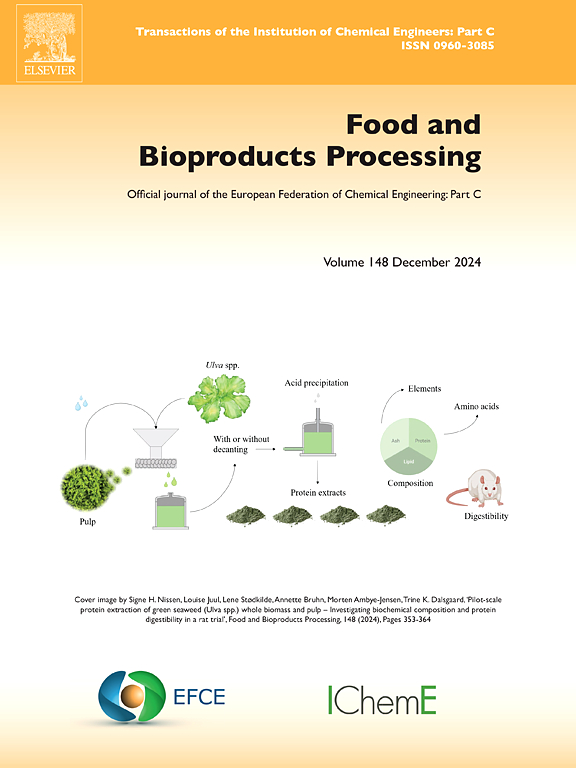Effect of ultrasound for postharvest preservation of carrot from an economic and environmental perspective: Experimentation and deterministic optimization
IF 3.5
2区 农林科学
Q2 BIOTECHNOLOGY & APPLIED MICROBIOLOGY
引用次数: 0
Abstract
The promising potential of organic agents in elevating food preservation during the minimal processing of fruits and vegetables has surfaced as a notable trajectory. The objective of this work was to evaluate the effectiveness of citric acid and ultrasounds power during carrot sanitization considering various acid concentration and exposition times. To this end, optimization and mathematical modeling tools are employed to assess the implementation of ultrasound technology (US) and citric acid for improved carrot preservation, considering both economic and environmental perspectives. The foregoing is based on an Mixed-Integer Nonlinear Programming (MINLP) optimization problem which allows the selection of which conditions of citric acid concentration and ultrasound time are economically suitable as well as the evaluation of their environmental impact. The model and optimization were generated from experimental data obtained at different sanitization treatments of carrots with citric acid (150, 400, and 900 ppm for 0, 15, 30, 45, 60, 90, and 120 min) in static and Ultrasound baths. Citric acid content, color parameters, and growth of microorganisms in the carrots during storage at 4°C (days 0, 3, 6, and 9) were evaluated. The citric acid and moisture content in carrots increased with the concentration of citric acid in sanitizing solution. Ultrasound increased the citric acid content in carrots by up to 17 %, particularly during the treatment process. However, the optimization results showed that, at 900 ppm of citric acid, both with and without ultrasound technology, similar improvements in shelf life were observed, including lower microbial loads and reduced color changes up to the sixth day of storage. However, the use of US technology increased the cost and environmental impact.
从经济和环境的角度看超声波对胡萝卜采后保鲜的影响:实验和确定性优化
在水果和蔬菜的最小加工过程中,有机制剂在提高食品保藏方面的潜力已经浮出水面,成为一个值得注意的趋势。本研究的目的是在考虑不同酸浓度和暴露时间的情况下,评估柠檬酸和超声波功率在胡萝卜消毒过程中的有效性。为此,从经济和环境两方面考虑,采用优化和数学建模工具来评估超声波技术(US)和柠檬酸对胡萝卜保鲜效果的影响。上述问题是基于混合整数非线性规划(MINLP)优化问题,该问题允许选择哪种柠檬酸浓度和超声时间条件是经济合适的,并评估其对环境的影响。该模型和优化是根据在静态和超声浴中柠檬酸(150、400和900 ppm, 0、15、30、45、60、90和120 min)对胡萝卜进行不同消毒处理的实验数据生成的。在4°C条件下(0、3、6、9天),对胡萝卜的柠檬酸含量、颜色参数和微生物生长情况进行了评估。胡萝卜中柠檬酸含量和水分含量随消毒液中柠檬酸浓度的增加而增加。超声波使胡萝卜中的柠檬酸含量增加了17% %,特别是在处理过程中。然而,优化结果表明,在900 ppm的柠檬酸浓度下,无论是否使用超声波技术,都可以观察到类似的保质期改善,包括在第六天的储存中降低微生物负荷和减少颜色变化。然而,使用美国技术增加了成本和对环境的影响。
本文章由计算机程序翻译,如有差异,请以英文原文为准。
求助全文
约1分钟内获得全文
求助全文
来源期刊

Food and Bioproducts Processing
工程技术-工程:化工
CiteScore
9.70
自引率
4.30%
发文量
115
审稿时长
24 days
期刊介绍:
Official Journal of the European Federation of Chemical Engineering:
Part C
FBP aims to be the principal international journal for publication of high quality, original papers in the branches of engineering and science dedicated to the safe processing of biological products. It is the only journal to exploit the synergy between biotechnology, bioprocessing and food engineering.
Papers showing how research results can be used in engineering design, and accounts of experimental or theoretical research work bringing new perspectives to established principles, highlighting unsolved problems or indicating directions for future research, are particularly welcome. Contributions that deal with new developments in equipment or processes and that can be given quantitative expression are encouraged. The journal is especially interested in papers that extend the boundaries of food and bioproducts processing.
The journal has a strong emphasis on the interface between engineering and food or bioproducts. Papers that are not likely to be published are those:
• Primarily concerned with food formulation
• That use experimental design techniques to obtain response surfaces but gain little insight from them
• That are empirical and ignore established mechanistic models, e.g., empirical drying curves
• That are primarily concerned about sensory evaluation and colour
• Concern the extraction, encapsulation and/or antioxidant activity of a specific biological material without providing insight that could be applied to a similar but different material,
• Containing only chemical analyses of biological materials.
 求助内容:
求助内容: 应助结果提醒方式:
应助结果提醒方式:


